|
|
|
|||
|
|
||||
|
|
||||
| Smoke Trails | ||||
|
|
HOME | SITE MAP | FORUM | CONTACT |
|
||
|
ABOUT | MOTORS | MODELS | ARCHIVE | HISTORY | STORE | FAQ | LINKS
|
|
|
|
|
|
||||||||||||||||||||||||||||||||||||||||||||||||||||||||||||||||||||||||||||||||||||||||||||||||||||||||||||||||||||||||||
|
Smoke Trails 16
(April 2008)
by Roger Simmonds Adapted from a column originally published in SAM 35 Speaks, April 2008 The more perspicacious reader will have realised that Smoke Trails 15 was a ‘first’ in that it had no reference to any scale models, be they true, semi, profile, past or present. Reasons for this aberration will become understandable, if not excusable, in this article, which also deals with things durational. But first – Leigh Richardson suggests the ‘young lad’ holding the early Jetex Vampire (Smoke Trails 13) was none other than Doug McHard, who, Leigh adds, “worked at Eaton Bray for DAGRA in 1946 or thereabouts”. Now Jetex was presented to the public only in 1948, so “1946” doesn’t quite tally with Leigh’s interesting conjecture – would anyone like to comment? Knowing my proclivities, Andy Blackwell sent me a copy of the Squib’s box top (below right). I find these artefacts irresistibly evocative: Proust can keep his madeleine, just give me the box top from a 1950s Jetex kit! |
|
||||||||||||||||||||||||||||||||||||||||||||||||||||||||||||||||||||||||||||||||||||||||||||||||||||||||||||||||||||||||||
|
But in this instance, the artefact is not only nostalgic but also informative: “Average flight 2 minutes” it says, and, more objectively, "2nd place 1955 SMAE Jetex Trophy”. Now this was Martyn Pressnell, who was (he has confirmed) the Squib’s designer and a club colleague of Mike King, the founder of Contest Kits. Thanks to Andy, Steve Bage has woven his AutoCAD magic on Squib’s plan and printwood and a PDF will soon be available. Old SAM members may remember that Terry Kidd wrote about some ‘Jetex-like Czech Jets’ that Stuart Lodge had seen at a Czech model rocket competition (‘Jet Reaction’, SAM Speaks, 1993). Though not explicitly identified as such, I take it that these were Synjets. Terry ended his brief discussion, “We hope we will be able to sample their product in this country in the near future”. Sadly, I don’t think we ever did. Interestingly, Stuart reported that the pellets were white, not the ubiquitous shades of brown of Wilmot Mansour, Sebel, V-Max or Tiger fuel. There have more ruminations in the Jetex.org Forum as to why Estes, the largest manufacturer by far of rocket motors, have not ‘cashed in’ on the revival of jet planes and produced a properly engineered Rapier clone, especially as Jan Zigmund is now muscling in on their territory with his high thrust motors. Paul Morris imagines an Estes board meeting could have gone something like this: Chief Suit (CS): “Ok, … so you put this motor in a model plane and you are then going to ignite it?” Junior executive (JE) nods happily. CS: “With a fuse? !! … then, you say, when it’s burning nicely, you sort of raise the plane to eye level and throw it?” Again, JE nods, this time not quite so happily. CS (with some asperity): “And while you do this … all that hot efflux is coming back at you?” JE gives a sad little nod … the proposal is wadded up into a small ball and lobbed into the green file. End of conversation. End of JE’s career. The moral of this story is, Paul concludes, “Let’s hang all the lawyers”. Amen to that! Note that JE would have been out the door even faster than a Scorpion’s burn time if CS had been told about Rapier blowouts. |
 Contest Kits Squib box top  Contest Kits Squib box top (detail)
- Andy Blackwell
|
||||||||||||||||||||||||||||||||||||||||||||||||||||||||||||||||||||||||||||||||||||||||||||||||||||||||||||||||||||||||||
|
|
|
|||
|
Apropos of these, my motivation to build all those scale jets of which I am enamoured is very low at the moment. A possible reason for my otiose state occurred to me whilst rereading Marriot Edgar’s great comic poem, ‘Albert and the Lion’ (right). You will remember that Wallace, the lion, had swallowed young Albert, and whilst Ma, Pa and the keeper agreed, “no-one was really to blame”, Ma took great exception to his advice to have more children: “At that Mother got proper blazing, / ‘And thank you, sir, kindly, said she, / ‘What waste all our lives raising children / To feed ruddy lions? Not me!’” I suppose I must resent, subconsciously, spending a great deal of effort on a beautiful model and then, in a manner of speaking, having it ‘eaten’ by a Rapier. Since duration models are more resistant to exploding motors, and we hope to run a Carlo Godel Memorial Contest (CGMC) at Middle Wallop, I find myself spending more time thinking (and writing) about these. I would like to persuade competitors to build Rapier L-1 powered designs of yesteryear for this (not overtly ‘vintage’) event. But modellers are an independent lot and many prefer to ‘roll their own’. However, careful consideration of the old designs will prevent them having to ‘reinvent the wheel’. With this in mind, I made a survey of ‘vintage’ plans and a review of 1950s articles, such as there were, pertinent to designing, building and flying Jetex duration models. Reading the vintage mags has, I’m afraid, done nothing for my literary style – you will have spotted two clichés a couple of sentences ago. Considering the developments that were taking place in Jetex duration design at that time, it is strange there were no articles in Model Aircraft, and only two in Aeromodeller, viz: ‘It’s designed for you number 16: Jetex’ (January 1952); and ‘Getting the best out of Jetex models’ (September 1953). Though aimed at the general reader, they contain some good stuff and intriguing hints about what Jetex contestants could get up to. |
 Albert and the Lion – not as noxious as model-devouring Rapiers? |
|||
|
The (unnamed) author of the 1952 article says of the rather dated illustration on the right, ”Being such a compact power unit, [a Jetex motor] will fit almost anywhere into a conventional or unorthodox outline [and] if we are primarily concerned with duration, we are more concerned with finding the most efficient, or what is apparently the best layout. … Both high and low thrust-line positions have been used successfully; as a matter of fact the ICI Challenge Trophy has been won by each. After trying both, Dick Twomey prefers a high thrust-line layout, believing that such a model has less tendency [sic] to loop under power and does not waste power in down-thrust. A typical high thrust-line layout may in fact be rigged (taking the tailplane as the datum line) with wings at +3° and thrust at 3° also, making the most of its available power.” Moving to the lower illustration, we are told, “The remainder of the design layout is fairly non-critical. The one really important factor is the size and disposition of the fin.” However, the writer (possibly RHW), whose logorrhoea, wordiness, long-windedness, and general verbosity imply ‘paid by the word’, continues: “But this is just the one point on which no empirical rules can be given!” Notwithstanding, he then provides some: “7.5% of the wing area should be more than adequate (up to 10% on a twin-finned design) and [it] would appear best if at least two thirds of this area [were] placed above the tailplane, assuming that the tailplane is roughly in line with the wings.” A wing area of 50 sq in is recommended for Jetex 50 power, with an aspect ratio of 6:8 being the best compromise between efficiency and practicality. There is advice on trimming, the ideal being, “a straight climb and a circling glide … this can be achieved with a little juggling and a lot of patience”. |
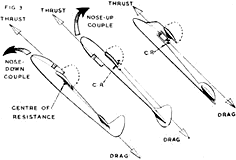  Two illustrations from ‘It’s designed for you’ – these were somewhat dated even at the time
- Aeromodeller, January 1952
|
|||
|
The article is hardly up to date – pylon mounting, as seen on Dick Twomey’s contemporaneous Stiletto for Jetex 200 (right), is for some reason not discussed. There is, however, one golden nugget amongst all the verbiage in a section entitled ‘Increasing the thrust’: “Dick Twomey offers his tips on this subject as follows: – try cutting down the diameter of ‘350’ pellets until they just fit your ‘200’ unit. ‘350’ fuel is much more concentrated, and performance is tremendously increased. Jet run will now be 10 to 15 seconds … the more air gap between the charges and the cylinder walls the more the power and the shorter the ‘engine run. “[This] is ideal for ratio events … [Dick's] ‘200’ size model produced ratios of 21:1 and 24:1 when thus treated, but it needs a stable model and painstaking trimming.” Dick also hinted at ways of ‘hotting up’ a 350 but declined to say how this was achieved – presumably by some sort of ‘core boring’? The (again unidentified) writer of the later 1953 article knew his onions, and though he covers much the same ground, he goes into greater depth and is not afraid of the odd equation. There is no mention of pellet modification – perhaps this dubious and dangerous practice had been outlawed, or the introduction of the Scorpion, with its high thrust short duration, and of Red Spot fuel, had negated any advantage it could give. Or the Aeromodeller lawyers, fearing litigation, had had a word with the editor. |
 Dick Twomey’s Stiletto – “a contest model for the Jetex 200 by one of the experts” (Model Aircraft)
- Model Aircraft, May. 1954 (p. 184)
|
|||
|
One phenomenon the author addresses at some length has also been discussed in a recent Smoke Trails, viz. rocket-propelled models are prone to loop towards the end of the power run. This is interesting in a scale model, but to be avoided at all costs in a duration model. Mounting a Rapier on the CG and reducing any shift of CG during the ‘power run’ can ameliorate this, but the model’s skittish behaviour is also be due to another, more subtle, factor. To quote the article: “The thrust from the motor is appreciably constant, but the efficiency increases over an appreciable part, if not the whole, of the power run”. There’s at least one too many ‘appreciables' there, but the writer includes a nice illustration (right) and the following lucid explanation of an often overlooked aspect of trimming any sort of ‘jet-propelled’ model aeroplane: |
 Figure 1 from ‘Getting the best out of Jetex models’
- Aeromodeller, September 1953
|
|||
|
“The efficiency of the jet unit is given by dividing the flight speed by the jet velocity. With a standard Jetex the exhaust velocity, or the speed at which the burning gases escape from the nozzle are [sic] of the order of 1000 feet per second [680 mph] or more. If stationary, then the efficiency is zero, since it is doing no work. As the model speeds up the ‘efficiency ratio’ increases. At just over 10 mph, it is 1/120, increasing to 1/40 at a little over 20 mph, and so on. With a given thrust output the model will, in fact, tend to speed up until the drag generated exactly balances the thrust.” The writer calculated that a Jetex 100 giving a thrust of 1.2 oz (about 350mN) developed 0.004 horsepower at 20 mph. The velocity of Rapier exhaust is somewhat higher, but doing the analogous calculations for an L-1 gives us a minuscule 0.008 hp or so. Not a lot, is it? |
||||
|
What we can learn from all this is that small streamlined models, especially if light, have a distinct advantage in the power phase – if we can prevent them looping! Trimming will always be painstaking and require patience (that’s what makes it fun), but the need for “a little juggling”, whatever that was, can hopefully be reduced by clever design. Mounting the motor on a tall pylon was one solution many of the early experts went for. John O’Donnell’s Castaway (right) will serve as an iconic example of the genre. Peter Michel, who sent me a copy of the plan, comments: “Looks to me like the ultimate in Jetex power! Strange to say, I hadn't noticed it before in all these years.” J O’D wrote about his only published Jetex plan (in Frank Zaic’s Model Aeronautic Year Book, 1957/58 ): “Castaway [is] latest in quite a long line of Jetex powered models of assorted sizes, shapes and weight, produced by Hugh and I [sic] over the last few years. Obtaining ratios of five or six [that is flight time to thrust time] was quite easy, but any more was a different tale. Due to the limited power and heavy weight of the Jetex unit [a Scorpion, or 600 in the US], a reasonable power/weight ratio of the complete model necessitated ultra-light model structure. Eventually the high thrust line layout was adopted and thus enabled looping to be controlled without resorting to knife edge trimming methods. The Castaway has a 76.5% CG which gives reasonable stall behaviour, and the very high location of the Jetex discourages loops. Flight pattern should be a very steep spiral with rudder to provide turns and wing warps to give roll. Duration of about 1:30 to 1:40 [min] off a single charge (7.5 sec effective) can be obtained in evening conditions without apparent lift.” Note that John mentions the dreaded loops twice! Incidentally, a still air duration of 1:40 implies an impressive ratio of about 13-14. J O’D knew then (and still does) what he was talking about – on the right we see him receiving the 1952 ICI Challenge Trophy from Mrs Mansour (with Joe himself beaming in the background). The ICI Jetex Trophy is of course not to be confused with the S.M.A.E. Jetex Cup that Bill Henderson won in 1951 (see Smoke Trails 11). John in this instance flew a 30" span Jetex 200-powered model designed by Hughie. This featured geodetic construction and a fuselage of Fizzles Galore Quite a few features, then, of the Castaway are worth emulating: the lightweight geodesic flying surfaces, the ultra-high thrust line and the usefully underslung fin. The Snowflake shares some of these features, but the Castaway is more sophisticated and of an impressive size. So can it be modified for a Rapier L-1? The Scorpion was easily the most powerful of Jetex motors that, despite its ‘600’ appellation, actually delivered about 5 ounces (1.5 N) of thrust. The Castaway has a span of 32", so for Rapier L-1 (of, say 60 mN thrust) it needs to be reduced by (3v60/1500 = 0.35), that is, to 35% of the original. This gives a span of about 11. Hmm … could be too small … a span of 16", a convenient 50% of the original, should be about right. |
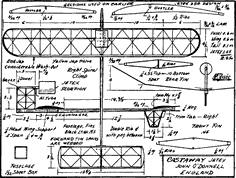 John O'Donnell's Castaway
- Frank Zaic's Model Aeronautic Year Book, 1957/58 (p. 176)
 “1952 ‘Superman’” John O'Donnell (as Aeromodeller dubbed him) with his Trophy-winning model (see below) 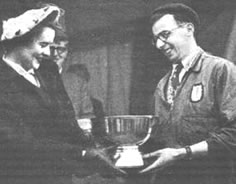 John O'Donnell being presented with the ICI Challenge Trophy at the Fourth Annual Jetex International Contest, Fairlop, 1952
- Aeromodeller, December 1952
|
|||
|
Looking for a smaller and simpler design that had at least some of the Castaway’s desirable characteristics, I came across ‘Fizzle XIII’ (detail right). Nice, I thought, and it wouldn’t need any reduction in size. Then I spotted a serious flaw – the motor is quite far back and there is no provision for the nose weight a Rapier would almost certainly require. Continuing the search, I found Ian Dowsett’s Fizzle Quick (below right). This is another sophisticated built-up design, published in AM in the early fifties. It is as lightly built as the Snowflake – those fuselage booms cry out ‘carbon fibre’ to modern eyes – but, unfortunately, it is also somewhat deficient in the proboscis department. Then I thought, “Why not build a Stiletto?” … Pylon mount, light geodesic structure … and I rather liked the idea of Stiletto with a Rapier! However, while Steve Bage might be able to knock ’em out in a couple of days, I can’t, and the Stiletto would take me two weeks of feverish spare-time activity. So I looked further for a simpler period design with a pylon mount. And there it was: Ian Dowsett’s all-sheet Fizzle-bug (below right). Perfect! Ian wrote (MA, March 1955): “Although of functional design, Fizzle-bug is a high performance contest model. No nose weight should be required [hurrah!] and flying trim is achieved by bending the trailing edge of the tailplane up or down. For power flights, use right rudder. [The] model should have a straight climb under power, going into a right-hand glide.” It will be remembered that John Emmet won the 1991 Rollie Lelliot Trophy with this one, powered by a Jetex 50. I don’t think any reduction for L-1 is required if it is lightly built, but the rather tall pylon could be reduced with beneficial effect. Your average L-1 gives about 14 sec of useful thrust, so a ratio of 8.5 will give you a max of 120 sec in a CGMC. Both Fizzle XIII and Fizzle-bug were found in the Jetex.org archives; the former is particularly nice, having been redrawn by Carlo Godel himself. Whilst fossicking in the archives, so to speak, I discovered that J O’D’s Castaway had already been contributed by Bill Henderson. Oh dear! Not only had I forgotten this when composing last month’s column, I had also neglected to follow the advice I always give others looking for old Jetex plans: “Have you looked in Jetex.org?” Serendipitously, I found the truly vintage Rudolph (right) also lurking there. This attractive Aubrey Kochman design was published in Air Trails, June 1950, and it is the first example (I think) of a pylon mounted Jetex motor. I wonder if Ian Dowsett knew of it? Apart from the pylon and all-sheet construction, there are other striking similarities to his Fizzle-bug – the swept wing and extreme dihedral for example. The latter was probably required to offset the destabilising effect of a heavy Jetex 50 and could easily be reduced for a lighter Rapier. |
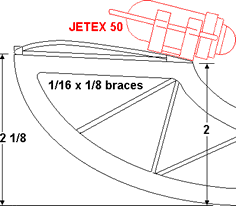 Detail of Fizzle XIII plan (redrawn by Carlo Godel) showing rearward placement of motor
- Original: Zaic’s Model Aeronautic Yearbook, ’64-65
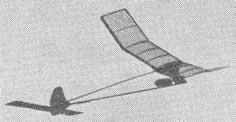 Ian Dowsett’s Fizzle Quick for Jetex 50
- Aeromodeller, Aug. 1955 (p. 408)
 Ian Dowsett’s all-sheet Fizzle-bug for Jetex 50
- Model Aircraft, Mar. 1955 (p. 104)
 The first design published in the United States for a Jetex 50-powered model and the first published example of a pylon mounted Jetex motor – Rudolph by Aubrey Kochmann
- Air Trails, June 1950 (p. 58)
|
|||
|
Finally:
Lindsey Smith recently observed in his ‘Scale Spot’ in SAM 35 Speaks (Jan. 2008) that there is a real difference of approach to scale competitions in the UK and US: whilst many UK scale models fly splendidly, this is not necessary to win, whereas in the US a scale model has to be capable of 120 sec. to be highly placed. Lindsey summed up the differences in one word: ‘flyability’. |
 Jetex Jemima
- Aeromodeller , Dec. 1953
|
|||
|
Two minutes is not too difficult, apparently, with diesel or electric power, but a real challenge with rubber. It is even more so with rocket power and this puts great constraints on the US jet jockey’s choice of subject. In the UK, the compromises required to achieve ‘flyability’ can be a liability (sorry!). For example, Mike Stuart flew a ‘true-scale’ Thunderchief in the 2005 Eddie Riding contest. His qualifying flight was just 15 sec. in the blustery conditions. James Campbell’s (semi-scale) MiG 15 demonstrated the ‘F’ word in spades with two flights of over 40 sec. in the same event. But Mike it was who lifted the trophy. In contrast, at Geneseo, the MiG 15, which has few ‘true-scale’ pretensions, has a very good chance of winning if beautifully built and finished (see right). So Dan Kane presented himself with an interesting challenge in building a Hawker Hunter for the next Geneseo meeting, and he looked at ways in which its ‘duration’ performance could be improved. He writes: “It is loosely based on the Skyleada plan with the wingspan increased to 15½" and [the provision of] a deep trough with downthrust [emphasis mine]. After conversations with Marty Richey and others, it is obvious that we need to get the wing loading down on scale jets in order to achieve any real endurance. The stabiliser has been increased by about 20% and a lifting airfoil is being utilized.” Steve Bage questioned the need for the latter: “I'd think twice about the ‘lifting’ (more correctly cambered airfoil) stab. Unless the area is increased hugely and the CG moved well back, it won’t lift on a design like this regardless of what airfoil you use. Whether a stab lifts or not is nothing to do with the airfoil but is related to the position of the CG relative to the wing's aerodynamic centre. So unless the CG is quite far aft (unusual on scale jets) it is best to use a thin symmetrical airfoil that produces minimal drag.” |
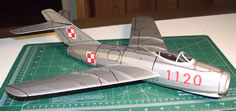 Chris Starleaf’s meticulously built Easy Built / Aristocraft MiG 15 won at Geneseo in 2006. Mike Stuart, from whose website the photo is purloined, comments: “The wingspan is 16 inches, weight a commendably low 22.5g without motor. The model is straight from the box, but Chris spent a lot of time on the details, and all those panel lines must have taken ages!”
- Chris Starleaf
|
|||
I agree with Steve; a ‘lifting’ tailplane is only useful for duration models when the CG is as far back as possible and the model – for example an A2 glider – is wafting about close to the stall. Our scale jets fly fast in the power phase and a cambered tail will create more drag and affect the climb. Readers will remember that my Hunter (right), built at original size with the original trough (and tail) flew splendidly in ‘UK’ terms; but it was no duration model and invariably came in to land a few seconds after flameout. After initial trimming, a little “juggling” (a tad more nose weight, a touch of down elevator) was necessary to prevent power loops with L-2 motors above 140 mN. Steve incorporated a ‘modern’ trough with downthrust in his latest Bell X-1E (right), which really does climb splendidly, without looping, whatever the motor, reaching a great height at the end of the power phase. The glide isn’t half bad either. Hopefully, modifying the Hunter’s trough will enable all the mighty horsepower of an L-2 to be used to climb high and not, as mine did (at least in the absence of a friendly thermal) beat up the airfield at low level. As an aside – would a MiG 15 with a modern trough have any chance in a CGMC? As to what a ‘modern trough’ looks like – well, a picture (or two) is worth a thousand words:
Above: Skyleada Hunter as designed by Ray Booth. The trough is quite shallow and provides little protection of the airframe from Rapier exhaust. Below: Hunter with a ‘modern’ deep trough that provides both more protection of the airframe and more downthrust. 
|
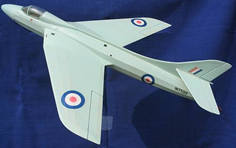 Roger Simmonds’ Skyleada Hunter replica
- Roger Simmonds
 Steve Bage’s Bell X-1E
- Steve Bage
|
|||
|
|
||||
|
|
|
|||
|
|
|
|
|
|
|
|
Acknowledgements - Article: Roger Simmonds - Illustrations: Steve Bage, Andy Blackwell, Carlo Godel, MAAC archives via Bill Henderson, Roger Simmonds, Chris Starleaf, Mike Stuart |
|
|
|
|
ABOUT | MOTORS | MODELS | ARCHIVE | HISTORY | STORE | FAQ | LINKS |
|
|
Terms of Use
|
Queries? Corrections? Additions?
Please
contact us.
|
|